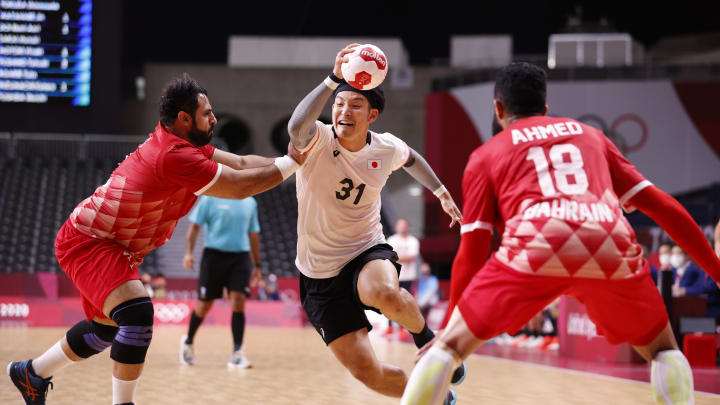What Are Olympic Handball Rules? Explaining Everything You Need to Know For Paris 2024

The Paris Olympics have finally arrived, and with the summer edition of the Games comes the more funky sporting events that many Americans have come to look forward to. Handball is one such sport.
Introduced into the Olympics in 1972, handball is an indoor sport featuring two teams of seven. There are a lot of similarities to soccer, except, you know, the ball is carried by hand by players rather than getting booted around. But using soccer as a frame of reference as far as the goal of the game (to score points by getting the ball past the goalie into the net) and penalties (red and yellow cards can handed out based on the severity of fouls) will help make understanding the game easier.
So let's get into it. How does Handball work?
Olympic Handball Rules
Let's start with the basics.
To play handball, there must be two teams of seven present on the court. The court itself is a rectangle, measuring 40 meters long and 20 meters wide divided by a center line. On each end a goal is placed in the center of the line, and those goals are surrounded by a six meter semi-circle called the "goal-area line." Only the goalie is permitted to roam in that area. The goals themselves are attached to the ground and run about three meters across and two meters high with a horizontal crossbar.
Each match is made up of two 30-minute halves for a 60-minute game. Overtime comes in the form of two additional five-minute halves and eventually sudden death if a winner is not established.
Substitutions
There is no limit on how many substitutions a handball team can make. Subs are made both during the action and during timeouts. However, the athlete entering play must wait until the player they are replacing is completely off the field. Otherwise it's a two-minute penalty for the offending player.
How to score
Related to how to play is how to score. The whole purpose of sport, after all, is to beat your opponent by scoring more points and handball is no different.
Whoever has the most points at the end of a handball match wins. There are strict rules regarding how to get the ball into scoring position, though.
In order to advance the ball, a player may take three steps with it. At that point, the player holding the ball must dribble (the same concept as with basketball, only with different form) or pass it. Players cannot use their feet but can use every body part above their knees to direct the ball where they want it to go. Players are permitted to pass, dribble, throw, push, hit, or stop the ball.
Points are scored in handball by throwing the ball past the goalie into the net of the opposing team. In handball those points can be scored in very dramatic fashion because players will often jump in the air to score. Not just because it looks cool, but also because the rules state only the goalie can stand within the goal-area line. Should an opposing player leap towards the goal, they are in legal position so long as they are in the air.
Observe:
How to play defense
Playing defense is where the comparisons to other sports become tricky. Defenders are not allowed to hold, hit, push, or trip opposing players. But they must have some way to secure possession other than just waiting for the offensive player to mess up, right?
Right! Defenders are allowed to steal the ball by using the flat part of their hand to knock the ball away from the opponent. They cannot violently slap it, but they can knock it away, which is a fine difference best appreciated by watching the sport.
But despite the specific above rules handball is a contact sport. Both teams will constantly use their bodies to move opponents around the court through sheer physicality. Offensive players can set screens for their teammates as they run or dribble, and defenders can use their bodies to obstruct opponents from getting to the ball.
Fouls
As in many sports, there are fouls in handball. Per NBC, a foul in handball is awarded, up to the opinion of the referee, when a player trips, pushes, hits, holds or commits any other type of offense toward another player on the opposite team.
However, similar to soccer, the referee may also rule that play will go on until the offense ends its push. In handball, that may come in the form of a goal scored, loss of possession, or any other stoppage in play like a free throw.
Free throws
Yes, you read that right! Handball has free throws. Here's how they work.
Free throws are quite common in handball because it's the default penalty for a basic infraction, i.e. a double dribble or regular foul. To initiate, the referee blows the whistle once and signals with one arm towards the side of the team that has been awarded a free throw. At that point, the free throw occurs.
But it is not a free throw like in basketball. Instead it is more akin to a free kick in soccer. When the referee awards a team a free throw, one player is chosen to stand in the exact spot where the infraction occurred. Defenders are required to give that player three meters of space to operate. Then the player can either pass the ball to a teammate or try to score from the spot of the infraction. This all may happen very quickly because the clock doesn't stop for most infractions so once the player gets the ball in the right spot, play resumes.
Yellow and red cards
As with soccer, referees are permitted to hand out yellow and red cards if they feel the severity of a penalty reaches the threshold. However, unlike in soccer, the card itself is not the only penalty.
If a referee finds a player guilty of excessive roughness or unsportsmanlike conduct, they can warn that player with a yellow card. If a player receives a yellow card, they are required to sit out for two minutes and their team has to play shorthanded during that time; in the handball vernacular, it's called a suspension. A second yellow card leads to another two-minute suspension, and a third leads to a disqualification in which that team will have to finish the match shorthanded.
A red card skips to the end. If a player gets a red card they are immediately disqualified from competition.
